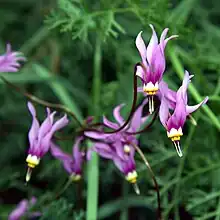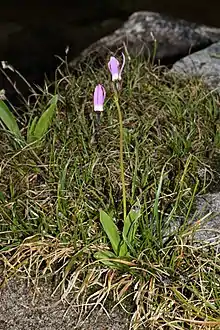| Primula sect. Dodecatheon | |
|---|---|
 | |
| Primula pauciflora (Dodecatheon pulchellum) (Fidalgo Island, Washington) | |
| Scientific classification | |
| Kingdom: | Plantae |
| Clade: | Tracheophytes |
| Clade: | Angiosperms |
| Clade: | Eudicots |
| Clade: | Asterids |
| Order: | Ericales |
| Family: | Primulaceae |
| Genus: | Primula |
| Subgenus: | Primula subg. Auriculastrum |
| Section: | Primula sect. Dodecatheon (L.) A.R.Mast & Reveal |
| Species | |
|
See text | |
Primula sect. Dodecatheon is a section of herbaceous flowering plants in the family Primulaceae.[1][2][3][4] Primula species in this section were formerly placed in a separate genus, Dodecatheon.[2] The species have basal clumps of leaves and nodding flowers that are produced at the top of tall stems rising from where the leaves join the crown. The genus is largely confined to North America and part of northeastern Siberia. Common names include shooting star,[5] American cowslip, mosquito bills, mad violets,[6] and sailor caps. A few species are grown in gardens for their showy and unique flower display.
The stamens are thrust out with the sepals bent back. The flowers are pollinated by bees, which grab hold of the petals, and gather pollen by vibrating the flowers by buzzing their wings (buzz pollination). The vibration releases pollen from the anthers.
Taxonomy

Carl Linnaeus created the genus Dodecatheon in Species Plantarum in 1753.[7] Dodecatheon could be distinguished by its buzz-pollinated flowers, with reflexed petals and projecting styles and anthers. Repeated molecular phylogenetic studies agreed with morphological and cytological evidence that Dodecatheon was most closely related to one of the subgenera of Primula, P. subgen. Auriculastrum, so that if Dodecatheon is kept separate from Primula, then Primula is not monophyletic. Accordingly, in 2007, Austin R. Mast and James L. Reveal reduced the genus Dodecatheon to Primula sect. Dodecatheon of P. subgen. Auriculastrum, and provided names in Primula for all former Dodecatheon species.[8]
Species
17 Primula species are placed in Primula section Dodecatheon.[8]
| Accepted name | Synonym(s) in Dodecatheon | Common name | Distribution |
|---|---|---|---|
| Primula austrofrigida | Dodecatheon austrofrigidum | Frigid shootingstar | Coast ranges of Oregon and Washington |
| Primula clevelandii | Dodecatheon clevelandii | Padre's shootingstar | California |
| Primula conjugens | Dodecatheon conjugens | Bonneville shootingstar | Wyoming to Oregon |
| Primula fassettii | Dodecatheon amethystinum | Jewelled shootingstar | Upper Midwest US, Pennsylvania |
| Primula fragrans | Dodecatheon redolens | Scented shootingstar | California, Nevada and Utah |
| Primula frenchii | Dodecatheon frenchii | French's shootingstar | Southeastern US |
| Primula frigida | Dodecatheon frigidum | Western arctic shootingstar | Alaska, NW Canada, Russia |
| Primula hendersonii | Dodecatheon hendersonii | Broad-leaved shootingstar | California to Idaho |
| Primula jeffreyi | Dodecatheon jeffreyi | Sierra shootingstar | California |
| Primula latiloba | Dodecatheon dentatum, Dodecatheon latilobum | White shootingstar | Washington to Idaho |
| Primula meadia | Dodecatheon meadia | Mead's shootingstar | Eastern US |
| Primula pauciflora | Dodecatheon pauciflorum, Dodecatheon pulchellum | Pretty shooting star, few-flowered shooting star | From Subarctic America to Mexico |
| Primula poetica | Dodecatheon poeticum | Poet's shootingstar | Washington, Oregon |
| Primula standleyana | Dodecatheon ellisiae | Ellis' shootingstar | Arizona, New Mexico, W Mexico |
| Primula subalpina | Dodecatheon subalpinum | Sierran shootingstar | California |
| Primula tetrandra | Dodecatheon tetrandum, Dodecatheon alpinum | Alpine shootingstar | California |
| Primula utahensis | Dodecatheon utahense | Wasatch shootingstar | Big Cottonwood Canyon, Utah |
Cultivation and uses
Several species are found in cultivation, including Primula latiloba (Dodecatheon dentatum), Primula hendersonii (Dodecathon hendersonii) and Primula meadia (Dodecathon meadia).
Species of Primula sect. Dodecathon need good drainage and often dry soils in summer and winter when plants are dormant, in the spring plants like moist soils for best growth. Plants grown in dry soils tend to be smaller and lower growing. Since plants typically go summer dormant, seed raised plants need three or more years of growth before they are large enough to bloom. For some species, if given frequent light fertilization and kept moist, dormancy can be delayed resulting in larger plants after germination and the interval between germination and flowering decreased by a year or two. Another technique to shorten the interval between seed germination and flowering is to place the plants in a cooler after dormancy has set in, in late spring, and after a number of weeks move the plants to a shadehouse in midsummer where new growth will start. The flowers produce seeds via buzz pollination.[9]
They can be propagated by division in winter.
Several varieties of the Pacific Northwest are edible.[10]
References
- ↑ "Primula L." ipni.org. International Plant Names Index. Retrieved 9 August 2020.
- 1 2 "Primula L." Plants of the World Online. Royal Botanic Gardens, Kew. Retrieved 9 August 2020.
- ↑ Reveal, James L. (2009). "Dodecatheon". In Flora of North America Editorial Committee (ed.). Flora of North America North of Mexico (FNA). Vol. 8. New York and Oxford: Oxford University Press – via eFloras.org, Missouri Botanical Garden, St. Louis, MO & Harvard University Herbaria, Cambridge, MA.
- ↑ Oregon Flora Project: Dodecatheon
- ↑ Treatment from the Jepson Manual
- ↑ Cassidy, Frederic G.; Hall, Joan Houston, eds. (1996). Dictionary of American regional English. Cambridge, MA: Belknap Press of Harvard University Press. p. 470. ISBN 0-674-20519-7.
- ↑ "Dodecatheon L." The International Plant Names Index. Retrieved 2022-04-15.
- 1 2 Mast, Austin R. & Reveal, James L. (2007). "Transfer of Dodecatheon to Primula (Primulaceae)". Brittonia. 59: 79–82. doi:10.1663/0007-196X(2007)59[79:TODTPP]2.0.CO;2. S2CID 36908769. Retrieved 2022-04-14.
- ↑ Taylor, Ronald J. (1994) [1992]. Sagebrush Country: A Wildflower Sanctuary (rev. ed.). Missoula, MT: Mountain Press Pub. Co. p. 120. ISBN 0-87842-280-3. OCLC 25708726.
- ↑ Benoliel, Doug (2011). Northwest Foraging: The Classic Guide to Edible Plants of the Pacific Northwest (Rev. and updated ed.). Seattle, WA: Skipstone. p. 141. ISBN 978-1-59485-366-1. OCLC 668195076.